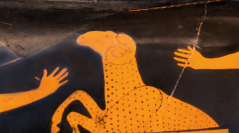

 Anthropozoologica
58 (13) - Pages 131-143
Anthropozoologica
58 (13) - Pages 131-143This paper proposes new perspectives on Aristotle’s discussion of the position of the heart and the presence of blood in the lungs. The accuracy of a detailed reconstruction of the internal topography of the human body, and of the resulting discursive presentation of its visualisation, would depend upon the specific experimental conditions from which this knowledge was derived. In particular, the difficulty or even impossibility of performing dissections on human corpses and the relative diffusion of knowledge about the anatomy of other animals resulting from sacrificial practice would play important roles in the constitution of a body of human anatomical knowledge. Our analysis will also bring to light experimental biases that could have shaped Aristotle’s ideas about human anatomy. It will do so through a rigorous multidisciplinary approach that combines tools of philological and cultural-historical research on the one hand, and modern experimental data from medical science, and especially from comparative anatomy, on the other, in order to gain a better understanding of Aristotle’s discussion on the human heart and lungs (HA 1.17).
Ancient anatomy, classical philology, dissection, sacrifice, animal experimentation.